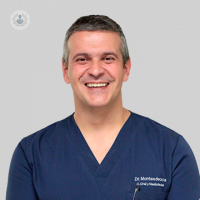Causes and treatment of sleep apnea
Written in association with:It is the appearance of respiratory pauses during sleep , which is characterized by the presence of snoring and fragmented sleep, and which produces daytime sleepiness. The latter is responsible for numerous traffic accidents and labor. It is associated with hypertension, obesity, diabetes and impotence, and decisively increases the risk of suffering cardiovascular accidents and stroke, as well as suffering from cancer.
What causes sleep apnea?
Sleep apnea is caused by obstruction of the pharynx during sleep, which limits the passage of air and, consequently, oxygenation. Alcohol and sleeping pills can contribute to aggravate the situation, as well as the accumulation of fat in the neck, have too large tonsils, tongue or palate or a small jaw.
What is the role of the oral and maxillofacial surgeon in the face of sleep apnea?
The specialist in Oral and Maxillofacial Surgery must evaluate the pharynx and the facial skeleton that supports the airway. However, the correct diagnosis and treatment requires the support of other specialists such as neurophysiologists and pulmonologists.

What is the treatment of sleep apnea?
It depends on the severity of the airway obstruction, the presence of associated diseases and the patient's preferences. Most adults are good candidates to use a CPAP, which consists of a nasal or facial mask that blows air under pressure. But half of the patients do not tolerate the continued use of these devices or suffer an anatomical alteration that produces the obstruction of the airway. It is these patients who will benefit from the different surgical techniques.
Tonsil hypertrophy requires a tonsillectomy. An elongated palate and uvula should be treated by uvulopalafaringoplasty. The deviated septum or a very large nasal concha can be corrected to improve tolerance to CPAP, but they will hardly solve apnea.
Some patients have a generalized obstruction of the superior route and a clear point of restriction to the flow is not identified. Others have hypertrophy of the tongue or a small jaw or maxilla. These patients are the best candidates to undergo orthognathic surgery, that is, the expansion of the airway by advancing the jaw and maxilla.
Patients with mild degrees of apnea will benefit from mandibular advance occlusal splints.
How is sleep apnea solved in children?
Infant sleep apnea is related to Attention Deficit Disorder and the correct neuropsychological development of the child. The most frequent cause is the obstruction due to hypertrophy of the adenoids, followed by the tonsils. A small undeveloped jaw or a narrow maxilla may aggravate this condition. These problems can be solved by jaw distraction or jaw expansion.
Is your result definitive?
The bimaxillary approach is the only surgical procedure that definitively solves a severe obstructive sleep apnea in correctly selected patients.
Can it be prevented in any way?
The control over the weight of the patient is the best preventive measure and must always be insisted upon in order to achieve stable surgical results.


